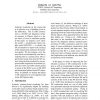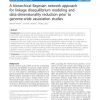52 search results - page 2 / 11 » Describing and learning of related parts based on latent str... |
ICML
2009
IEEE
14 years 7 months ago
2009
IEEE
This paper describes an unsupervised learning technique for modeling human locomotion styles, such as distinct related activities (e.g. running and striding) or variations of the ...
COLING
2010
13 years 1 months ago
2010
Syntactic reordering on the source-side is an effective way of handling word order differences. The (DE) construction is a flexible and ubiquitous syntactic structure in Chinese w...
IJNS
2010
13 years 4 months ago
2010
Abstract: Cascade process, such as wastewater treatment plant, includes many nonlinear subsystems and many variables. When the number of sub-systems is big, the input-output relati...
BMCBI
2011
12 years 10 months ago
2011
Background: Discovering the genetic basis of common genetic diseases in the human genome represents a public health issue. However, the dimensionality of the genetic data (up to 1...
SAINT
2005
IEEE
14 years 18 hour ago
2005
IEEE
Inductive Logic Programming (ILP) is a combination of inductive learning and first-order logic aiming to learn first-order hypotheses from training examples. ILP has a serious b...


